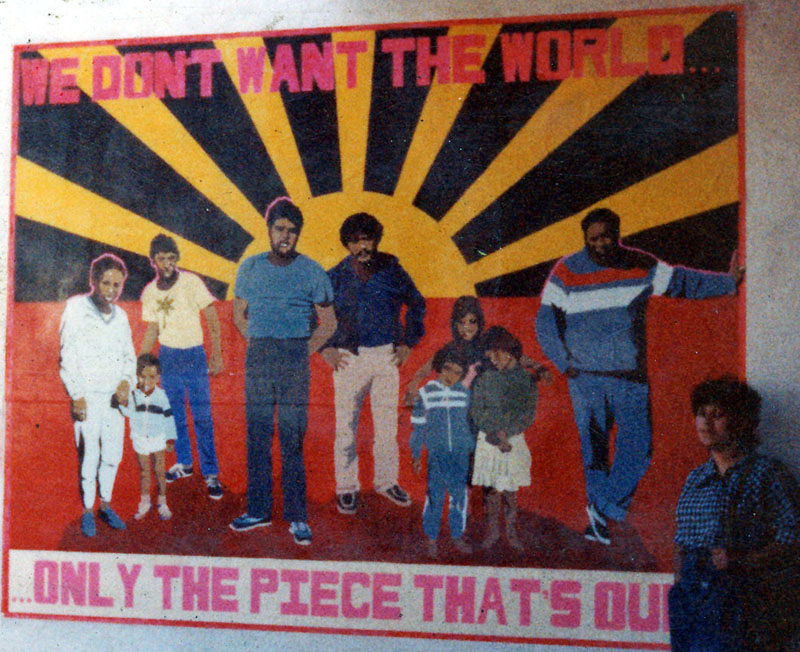|
|
Thursday, December 18, 2025
|
|
|
|
|
Sydney Community Billboard Project

The community billboard project was initiated in October 1983 by community artist Grahame Khime and the South Sydney Youth Services Committee.
The South Sydney Youth Services Committee had representatives from local community groups including Alexys CYSS, South Sydney Community Aid, Redfern Health Centre, Sydney City Council, The Factory Community centre, The Settlement, Clevo High School, South Sydney Women's Centre, and the Waterloo Girls Activity Centre.
It was aimed at providing prominent 'billboard style' advertising space for the many and varied community groups in the South Sydney area, illustrating important issues to them.
The initial aim was to build or obtain and repair a number of billboard sites in the South Sydney area. These billboards would then be used to advertise the interests and various activities of community based groups and agencies in the area, as well as providing the opportunity for a wide cross-section of community members to be involved in a constructive community arts activity through those agencies. It was initially planned that the displays would be changed at regular intervals [e.g. about two months].
The two main objectives were then described as:
'Firstly the provision of public spaces for community organisations in which to develop a community art form which provides for their specific interests. The format of a temporary billboard provides for direct and continuous participation by a variety of groups. It is significant to note that the billboard format is presently the province of commercial and corporate interests. Whilst not regarded as an art form, it is a persuasive and dominant feature of our visual culture and an effective communicator. The concept of community billboards is to arrest some of this space and make it serve the interests of community groups by advertising their concerns. Similar projects have been conducted overseas n England and the United States as well as those which are currently in progress in other urban and suburban areas around Australia.'
The second main objective was to provide local people with skills e.g. designing and painting, liaising with all sectors of the community, publicity and project organisation.
A working space for the project was obtained from the Rachel Forster hospital in premises at Alexys CYSS, 197 George St. Redfern.
STAGE ONE
A billboard site was obtained and rent Paid for by the committee at the cost of $50 per year. The wall, located at 195 Regent St, Redfern Participants at Alexy's CYSS, with the guidance of Graham Khime, created Stage One. The mural was designed and painted around the theme 'Unemployment, The big lockout'. The opening ceremony saw the attendance of a wide cross section of the media, ranging from local newspapers like 'The Guardian' to major dailies like 'The Herald' and 'The Telegraph'. The story was also covered by Channel 0/28's 'Lineup 28' program. The residents and community agencies could now see a very real opportunity to express themselves in an important public forum. All labour to this point was voluntary.
STAGE TWO
The second piece was at 199 Regent St, Redfern. 'We don't want the world ... just the piece that's ours' was initiated by The Settlement, designed and painted by Cheryl Davison [community artist in residence at The Settlement, with trainee community artists Amanda McCoy and Joanne Innes. Amanda and Joanne were employed by The Sydney City Council under the Youth Employment Scheme. The issues illustrated by The Settlement were Aboriginal land rights, and racism. An opening ceremony was held Tuesday 24th July, 1984, and the mural was launched by David Burns, board member of The Settlement, followed by a reception at The Settlement.
STAGE THREE
Research started for the the next billboard on issues of housing and tenancy among low income earners. One suggested location was a site secured from the State Rail Authority at Redfern Station.
Source: Report held at The Settlement
|
|
|
 |
|
|
|
|
|
|
 |
 |
| |
Terms Of Use
|
Privacy Statement
|
Copyright (c) 2025 Redfern Oral History
|
Register
|
Login |
Website Solution: Pixel Alchemy
|
|